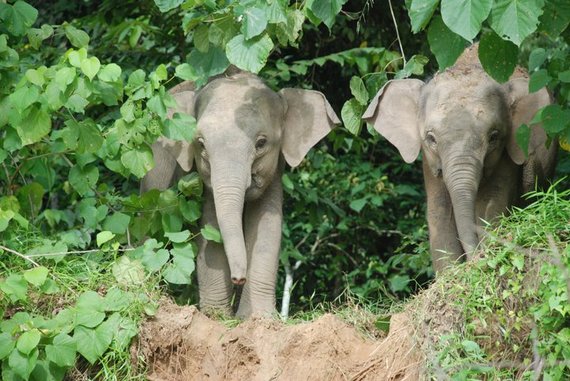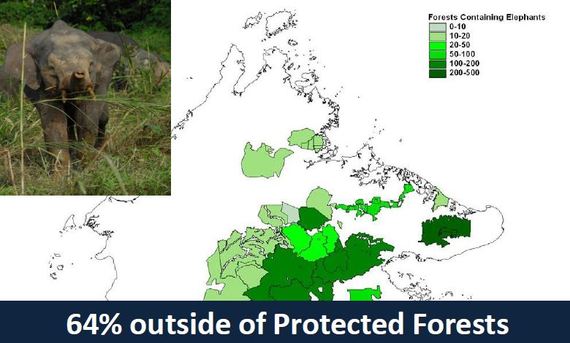The Sabah Wildlife Department issued a dire warning last week over the survival of the last remaining elephant population in Borneo. The African elephants have been the focus of media attention so much so that some people are surprised to find out that there are elephants in Indonesia and Malaysia and not just orangutans.
This mono species conservation focus which has most conservation dollars going towards saving orangutans is casting too much of a shadow over species like the elephants. More efforts have to be placed on habitat preservation. In fact, if saving the orangutans is truly a global goal for conservation, we should use the Asian elephant ( Elephas Maximus ) as an icon species instead of the orangutan.
Look at it this way. The estimated population of the Bornean orangutans still floats around plus or minus 50,000 animals depending on which report you read. The Bornean elephant( Elephas Maximus Borneensis) on the other hand, has been estimated at less than 2,000 animals, most of which are in Sabah state, Malaysia. The Sumatran elephant( Elephas Maximus Sumatranus) fares no better with less than 2,000 animals remaining compared to an estimated 6,000 Sumatran orangutans and yet the monthly deaths of Sumatran elephants rarely gets exposure in popular media.
Wild animals need big areas to survive in, elephants more so. It's a well known fact that there isn't enough money or interest in saving all threatened wildlife but there is a good chance that if we could focus on habitats rather than exclusive sanctuaries or safe enclosed areas, we could possibly even save species like the wild buffalo( banteng as it's called locally )and the pangolins in Sabah as happy beneficiaries of holistic conservation. Both of which are reportedly near extinct. Unfortunately, neither the banteng nor the pangolin is cute enough to be an iconic species.
So, if we are choosing which animal to be an icon based on their level of cuteness, well then, baby elephants can be darn cute too! Just look at this photo from Bornean elephant expert, Megan English, of baby elephants in Sabah state, Malaysia. This has to be the cutest thing you'll see this week!
Unfortunately, Sabah state is also the same place where the poisoning deaths of 14 elephants in 2013 made headlines around the world.
This should come as no surprise to anyone familiar with conservation issues in Sabah. Way back in 2012, I received a report indicating that human-elephant conflicts would rise over the years. The report which was prepared jointly by a local NGO and the Sabah Wildlife Department indicated that some 64% of the elephants were found outside of protected forests. Local news reports on human-elephant conflicts since then have served to confirm that report's warnings.
A recent study on the elephants and one of their key habitats in the Lower Kinabatangan Floodplain can be accessed here. The report comes with a warning that the future of elephants in Sabah is questionable if isolated populations continue to in-breed.
Action Now or Future Extinction
In last week's public statement, the Director of Sabah's Wildlife Department, William Baya called the rescue of baby orphan elephants a "worrying trend " and appealed to Malaysian corporations to help fund their rescue.
I am extremely concerned about what is happening to our Bornean Elephant population in the wild . For the past three years we have rescued 15 baby elephants , all below 1 year old that were found wondering alone. The numbers are actually on the increase when in 2013 we rescued 2 babies, followed by 3 babies the following year and in 2015 ,we rescued a record of 8 babies. Though 2016 has just dawned , we have already rescued 2 baby elephants just in the month of February alone.
Assistant Director, Dr Sen Nathan was more emphatic in his assessment of the situation.
Coupled by this alarming trend of orphans being rescued which basically means mothers are being killed, could spell a deadly cocktail that would lead the Bornean elephant on the same trail of extinction as the now extinct in the wild, Bornean Rhinoceros of Sabah. We should never ever allow our Bornean Elephants to join the Bornean Rhinoceros to that path. Steps must be taken right now and not 20 years down the road on both in-situ ( in natural habitat) and Ex-situ (managed /captive breeding) conservation to save our elephants in Sabah
Saving Bornean Elephants Should be a Global Project
While I expect companies like Sime Darby and the Malaysian Palm Oil Council to answer the wildlife departments call for help and increase conservation funding in Sabah, this won't be anywhere near enough to save the entire population of elephants. The timber industry in Sabah must get involved as part of a wider local campaign to ensure their survival. International conservation groups like World Land Trust which ran a successful fundraising campaign in 2014 to save parts of the elephant's habitat in the Lower Kinabatangan Floodplain have to do more.
Numerous studies and research on wildlife have been conducted in Sabah over the past few years. The knowledge gathered would be wasted if it's not used in a statewide campaign to save wildlife. The question will be whether the Bornean pygmy elephant will be considered worthy of a global campaign. Heck. It has to be. Why should anyone expect local villagers to get into conservation when Sabah's endangered wildlife only gets a sideways glance from the international community? I leave you with this full length documentary on them. Hopefully this will inspire that worldwide campaign that is needed to save this endangered elephant.

